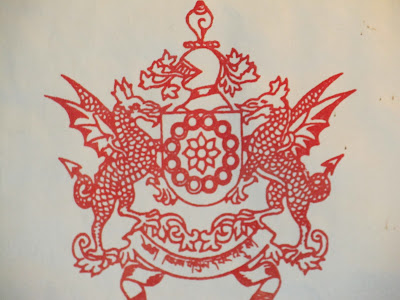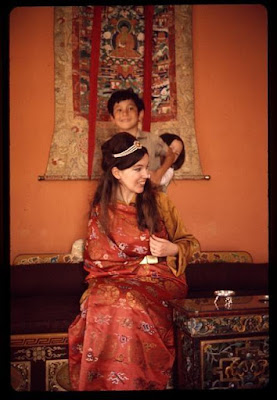 Prince
Paljor Namgyal, the first and the only Pilot prince of Sikkim
was born on 26thNovember, 1921 at the Royal Palace, Gangtok to the Eleventh Maharaja of Sikkim, Sir Tashi
Namgyal, K.C.I.E, K.C.S.I. and Maharani Kunzang Dechen. His original name
was Kunzang Choley and he was the eldest son
of the Eleventh Royal Couple of Sikkim. In 1930, he was sent along with his
younger brother, Prince Palden Thondup Namgyal and their sister Princess Pema
Tsedeun to St. Joseph’s Convent, Kalimpong. Prince Palzor Namgyal was
further educated at St. Paul’s School, Darjeeling and St. Joseph’s
College, Darjeeling.
Prince
Paljor Namgyal, the first and the only Pilot prince of Sikkim
was born on 26thNovember, 1921 at the Royal Palace, Gangtok to the Eleventh Maharaja of Sikkim, Sir Tashi
Namgyal, K.C.I.E, K.C.S.I. and Maharani Kunzang Dechen. His original name
was Kunzang Choley and he was the eldest son
of the Eleventh Royal Couple of Sikkim. In 1930, he was sent along with his
younger brother, Prince Palden Thondup Namgyal and their sister Princess Pema
Tsedeun to St. Joseph’s Convent, Kalimpong. Prince Palzor Namgyal was
further educated at St. Paul’s School, Darjeeling and St. Joseph’s
College, Darjeeling.
The Crown Prince, Paljor Namgyal was commissioned as a Pilot
Officer in the Royal Indian Air Force and based
at Ambala. He served in World War II in 1940-41. As a true ally of the
British Indian Government, Sikkim had greatly served in providing manpower in
the said world war. It is to be noted here that many Sikkimese family had also
send their children to fight against the English foes and few of them had been
able to receive the
esteemed Victoria Cross. But, most wretchedly,
Paljor Namgyal was killed in active service after he crash landed in flight
near Peshawar, on 20thDecember, 1941.
He was merely 20 years old then. Regarding the death of the Crown Prince
of Sikkim the Bharat Rakshak an official website of Indian Air Force has published
this information “On 8th December, war
was declared with Japan and the Squadron was ordered to the Burma front on 14th
December. The Squadron returned to Peshawar two days later. As there was
a shortage of air gunners, volunteers were called from among the fitters,
riggers and other ground crew members. The airmen volunteered almost to a man.
They were trained on a fast track basis in less than a fortnight. The Squadron suffered its first casualty on the Lysander on 20th
December 1941, when Pilot Officer Paljor Namgyal, who at that time was the
crown prince of the Kingdom of Sikkim, undershot trying to land at Peshawar.
The aircraft R1989 hit a bund and overturned - killing the pilot and seriously
wounding the observer”.
The tragic death of
the Sikkimese Prince has also been mentioned by PVS Jagan Mohan in his book ‘The
Westland Lysander in Indian Air force Service’ in the following manner “The squadron suffered its first casualty on
the Lysander on 20th December 1941, when Pilot Officer C Dhairyam,
with Pilot Officer Paljor Namgyal as his passenger undershoot trying to land at
Peshawar. The Air craft R1989 hit a bund and overturned - killing the pilot and
seriously wounding the pilot. Palzor Namgyal was the Crown Prince of Sikkim and
his death was a major blow to the people of the small Himalayan Kingdom”(P14).
.jpg) |
| As an Air Pilot Prince Paljor Pic: http://sikhim.blogspot.com |
Most
unfortunately, we have very little credentials about the pilot prince Paljor
Namgyal. Few photographs that include his portrait in the Air force uniform are
the only source to write something about him. During my fieldwork, I have been
able to get a bit of unwritten information about the late Crown Prince of
Sikkim. Few old Sikkimese, especially those who have seen him during their
lifetime, have an immense respect and love for Paljor Namgyal. An old person
Mr. Harka Bahadur Subba of Chota Singtam along with few old people has informed
me that the Prince was a placid and a kind person. Once while hunting Prince
Paljor reached to a house of an old Lepcha lady at Nandok in East Sikkim. She was
unaware about his gigantic position and she offered Dhero (meal prepared from
millet mostly consumed by the poor peasants during feudalistic Sikkim) to him
for his dinner. He inquired about the poverty of the old lady and came to know
about the forceful collection of Dhurikhajana and the prevalence of Kalobhari,
Jharlangi and Theki bethi as forced labor. After spending
a night at the home of the old lady the prince recoiled to his palace and
informed his father Maharaja Tashi Namgyal about the utter poverty of their
subjects and insisted him for the immediate removal of the forced labour and
Dhurikhajana. Before the king could do anything in this regard, the Kazis and
other feudal elements misguided the king to send his eldest son to join the
Royal Air Force and was finally killed in an air crash.
 |
| Photo Frederick Williamson Prince Paljor Namgyal standing in front of C. E Dudley Pic: Digital Himalayas |
“Maharajkumar jyudo hunuhunthyo bhaney ta
Sikkim aarkai hunthyo had the Maharajkumar been alive Sikkim could have
been different” was their remark on the untimed demise of the late crown prince
Paljor Namgyal.




























































